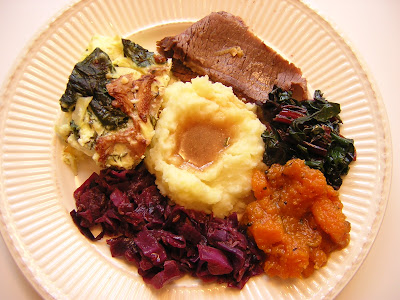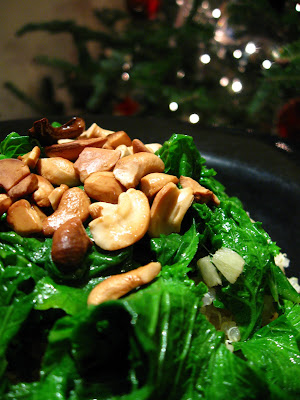
Thanksgiving 2009, clockwise from top: polenta cakes with cranberries,
kohlrabi-carrot slaw, prosciutto-wrapped sweet potatoes with sage, pumpkin noodle kugel,
garlic-roasted Brussels sprouts in balsamic vinegar, and cranberry-beet sauce.
Welcome to a special traveling edition of D4SA! We cooked this year's Thanksgiving dinner at Lizz's parents' house in Philadelphia. None of us are crazy about turkey, so instead we decided to pick several smaller, mostly-vegetarian dishes that were seasonally appropriate and called on traditional Thanksgiving flavors. For this we relied heavily on
this list created by Mark Bittman, author of the standby cookbook
How to Cook Everything. It contains tons of ideas for holiday dishes that can be made in advance so that everything isn't competing for the oven at the last minute. Although most of these dishes could be prepared ahead of time, we decided instead to do the traditional Thanksgiving cooking marathon for several hours before dinner. Below are some before-and-after photos of each dish, for your viewing pleasure.
Some beautiful fresh local cranberries:

In a traditional cranberry sauce, the berries are just simmered with water and sugar until they all pop and break down. (Some people add gelatin for a firmer texture.) But Mark Bittman suggested adding sweet and earthy grated beets:

The beet and cranberry are simmered together with a little orange juice, grated orange rind, and maple syrup to taste:

With time the ingredients broke down and combined; the sauce ended up with a naturally and pleasantly thick texture, and a more earthy, complex flavor.
 Check out the museum-quality flatware!
Check out the museum-quality flatware!For the only meat dish of the meal, we wrapped wedges of pre-boiled sweet potatoes in sheets of prosciutto, enclosing a sage leaf in each one.

The wraps are thrown into the oven to roast briefly, just until they have attained a nice crispy texture.

The pumpkin-noodle kugel required a couple more steps than some of our other dishes, but would have been easy to do if we had started with some frozen pureed pumpkin. Instead we used this beautiful white "moonshine" cooking pumpkin, purchased by Lizz's parents at a local food stand:

The pumpkin was scraped out and cut into quarters, then placed cut side down on a baking sheet and baked until soft. We then scraped out the flesh (using a grapefruit spoon....very high-tech) and pureed it in the blender.

From that point, it was simple to add it to the kugel: we just boiled some egg noodles, and separately mixed eggs, milk, pumpkin puree, melted butter, and cinnamon in a bowl. We then layered the noodles and the milk mixture in a couple large casseroles and topped both with breadcrumbs. The kugel baked for a little under an hour, until a knife inserted in the center came out clean.
Meanwhile, we made the kohlrabi-carrot slaw our faithful readers may remember from its recent appearance on our blog. Here the kohlrabi slices are draining in a colander after being tossed with salt:

For a big holiday meal, it's nice to mix dishes you already know how to cook with ones that are new to you - we enjoyed making the easy kohlrabi dish but also trying out our first kugel.

For a green veggie, we reprised the balsamic Brussels sprouts which were also featured on the blog recently.

We put a twist on the traditional cornbread by instead making Mark Bittman's polenta cakes this year. Polenta can be a soft, creamy "pudding"-like dish or it can appear in a more solid form like this. The final texture is determined by the amount of liquid you add and how long you cook it, but you can also crisp up polenta by pan-frying or (as we did here) broiling the individual pieces. For this recipe we made polenta as usual, using a relatively smaller amount of liquid, and also mixing in some chopped fresh cranberries. After spreading the polenta in a baking dish to cool, we cut it into these little cakes and put them on a baking sheet under the broiler until they became crisp on both sides.

As Bob Dylan once said, behind every beautiful thing there's been some kind of pain - and this meal was no exception. Sadly, Lizz's bicep was a casualty of the baking process. It made some inopportune contact with a hot oven door and now bears a dramatic two-inch-long burn mark.
 ...but ya shoulda seen the door!
...but ya shoulda seen the door!Of course, the meal wouldn't have been complete without dessert. But in this, D4SA had the assistance of a special guest chef - Lizz's dad made one of his famous pies. We had requested pecan, and that is what we got:

For those of our faithful readers who made it this far - we're thankful for you this year!





















































